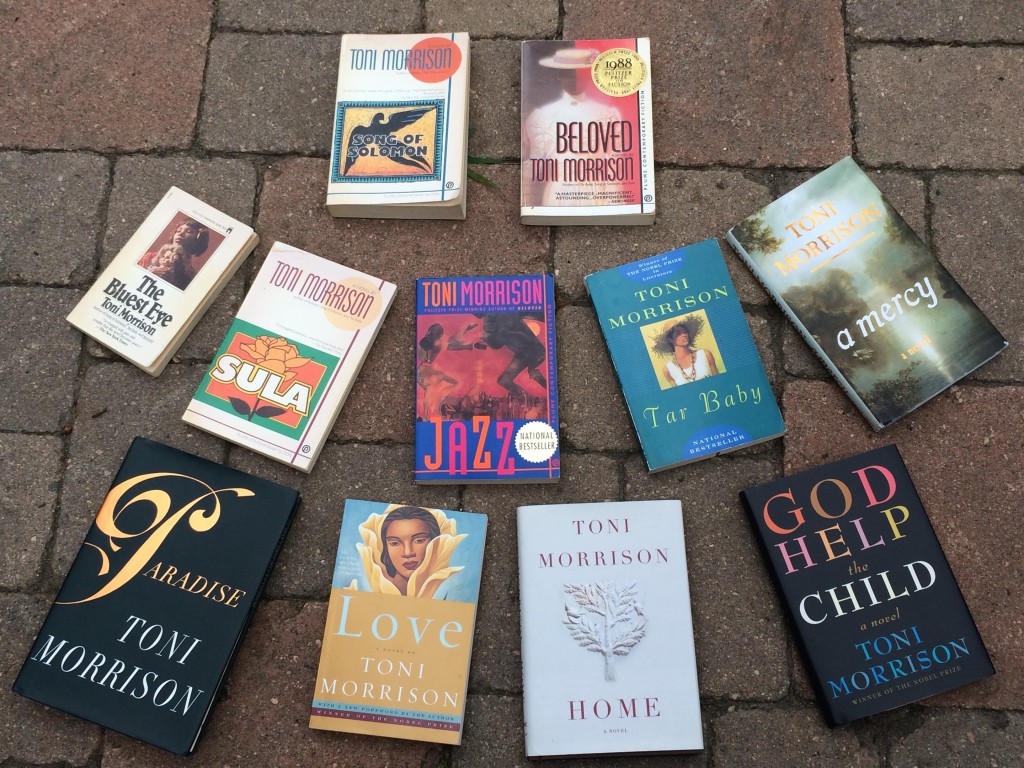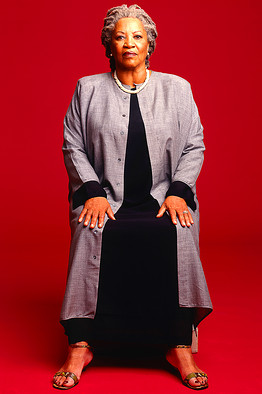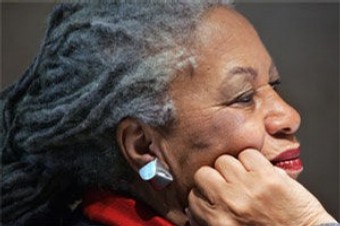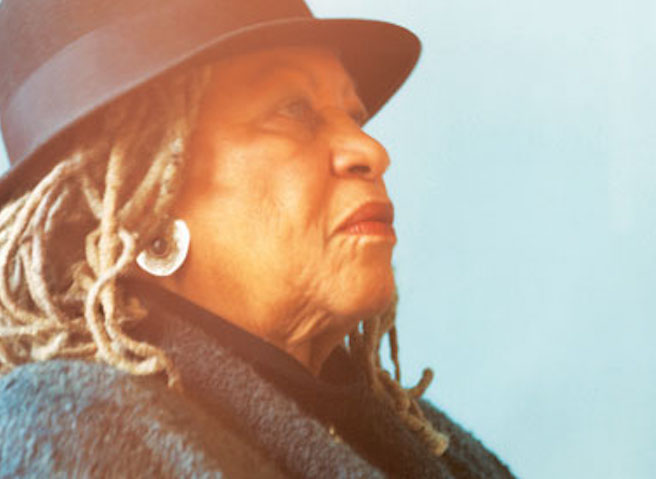
At some point during the writing of Beloved (1987) a daemon gave Toni Morrison the following line: “124 was spiteful. Full of a baby’s venom.” Only a pedant would see two sentences here. It is one, albeit a rarity, requiring a full stop after the third word to create the frisson after the eighth. “124 was spiteful.” Stop. Your pulse quickens. “Full of a baby’s venom.” Stop. Your stomach drops. A comma simply wouldn’t do. Together, these two phrases comprise a first line equaled for power in American fiction only by “Call me Ishmael.” The book stands solidly behind this opening sally and has been integral to Morrison’s rise to prominence among Melville’s descendants.
Much of Beloved’s greatness inheres in it’s unabashed embrace of large themes. It’s point of departure is a catastrophe of classical concision: An escaped slave slays her infant to save it from re-capture. The baby refuses to accept this fate. The story, radiating both forward and backward from this event becomes, not an inditement of slavery – too banal a subject for an author of Morrison’s intelligence – but a tally of the awful cost of accepting freedom. No one dodges collection, and in the case of Sethe, the mother in question, the price is very nearly too high. The characters who live in the shadow of her tragedy go at their lives like figures leaping from Shakespeare, the Greek stage, or the Hebrew Scriptures. Denver, Sethe’s surviving daughter, deals by never setting foot outside the home, but in the end, like Miranda moored on Prospero’s island, she must discover a brave new world. Baby Suggs, Sethe’s mother-in-law, is like Moses, whose faith buoys the multitudes but fails her at the border of the Promised Land. Paul D., Sethe’s mid-life lover, shares with Jonah the inability to escape the imperative of redemption. It is hard to ignore a family resemblance between Sethe and Medea; both are mothers in extremis who commit infanticide. And what of Beloved, the slain, the ghost at the heart of this ghost story? She is both terrifying and fragile. She knows something of Electra’s furry at a mother’s betrayal, but behaves like a heartsick vampire, feeding desperately, and so sadly, on her mother’s “too thick” love. Ultimately, she is as empty as Narcissus, a shell animated by the only real haunting power in the novel – the past.
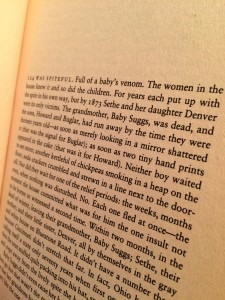
Toni Morrison’s use of language has been called poetic, lyrical, baroque. These descriptors are misleading as they often bring to mind a torqued, extended, or otherwise heightened syntax which, while not unknown to her, is not a defining trait. I think what readers who invoke these adjectives are responding to is not so much her sentence-by-sentence choices of language as her way of constructing a narrative. At her best, she is wonderfully oblique. Her reader may understand every word but have to ponder just what has been communicated. The result is not confusion, but suspense. Here is Sethe and Denver near the beginning of Beloved after trying, and failing, to reason with the ghost of the infant, as yet only a tantrum-prone shimmer:
“For a baby she throws a powerful spell,” said Denver.
“No more powerful than the way I loved her,” Sethe answered and there it was again. The welcoming cool of unchiseled headstones; the one she selected to lean against on tiptoe, her knees wide open as any grave. Pink as a fingernail it was, and sprinkled with glittering chips. Ten minutes, he said. You got ten minutes I’ll do it for free.
Not to put too fine a point on punctuation, but notice the lack of a comma between “Sethe answered” and “and there it was again.” It is a move as subtle as a film director’s choice in the direction of a pan shot. What follows is a memory. At first we’re not sure of what, but that it doesn’t merit even a comma’s worth of separation from the present tells us that we are mid-stream in a torrent. We try to get our bearings. When we realize that Sethe traded sex with the stonecutter for the carving of the single word, “Beloved”, on the headstone of her infant, the fact that she took time to notice the fingernail pink and glitter of the stone against which she leaned raises our neck hairs. Significantly, the only mention of a grave in this passage is in a stark reversal of the usual implication of parted knees. And the cool of the headstone? It was welcoming? Here we go. For Morrison at her best, style is strategy.
*
It is a strategy which has made Toni Morrison, at her best, among the most powerful writers in American literature. When she falls short of her best, she still fascinates, if only for the spotlight her misses shine on their own divergence from her hits. Her latest novel, God Help the Child, published in April this year, contains so many elements of her best work it’s like an account sheet of a legacy: Here is the turbulent past acting on the present; a protagonist at war with herself; sex, both destructive and healing; and, sure to delight, the incursion of the supernatural. Everything is set to become a dazzling Morrisonian feast. And by the time the reader comes to the last page – the ingredients have remained ingredients. The master chef, it seems, has lost the courage to cook.
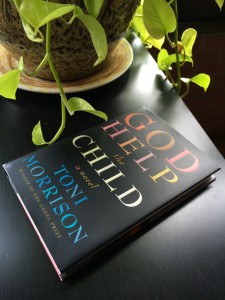
It is the story of a young woman in distress. Bride, born with skin as dark as genetically possible, finds her way through life by measuring the response her striking appearance elicits in others, much as a bat maneuvers by echolocation. Because the genetics of her dramatic coloring are obscure, her light-skinned father assumes the infidelity of her mother and abandons them. Her mother, in thrall to the insidious color ranking system within the black community, is a “high yellow”, and finds her daughter’s “Sudanese black” skin repellent. So much so that she won’t even allow her to call her “mother”, insisting instead on the sobriquet, “Sweetness”.
The defining event of Bride’s early life is a court case against a teacher charged with collaborating in child molestation. Bride (né Lula Ann) is brought in as a key witness. She tells the court what she hopes will elicit love from her unloving mother. The consequence of her choice redounds to the fictional present. Against her mother’s expectations, she grows into a stunning beauty. She rises through the ranks of a cosmetics company and is on the verge of launching her own line, which she calls “YOU, GIRL”. Ironically, she sells her image by wearing no makeup at all, nothing to mute her startling blackness, thereby commodifying the genetics her mother so hated. Like most of Morrison’s protagonists, she is not a thinker, existing by and for her passions. When she can no longer live with the damage caused by her court testimony, she thinks in grade-school equations: she did something bad, so she’ll do something good to cancel it out. When her gesture of what she imagines to be reconciliation is not received as such, she is knocked out. Literally. Around this time she falls for Booker, a sexy drifter with violence in his own past, a peculiarly old-school taste for jazz and trumpet playing, and a penchant for the Western literary canon. She shows a nearly pathological lack of curiosity about him until he leaves her with the words, “You not the woman I want.” In a turn for the bizarre, she begins losing body parts, first ear piercings and pubic hair, then breasts and menstrual cycle. Compounding the strangeness, only she seems to notice.
Physically, Bride, at least when fully assembled, is at home in the company of Morrison’s perennial bombshells. It’s not hard to imagine Sula (Sula), Hagar (Song of Solomon), Jade (Tar Baby) Dorcus (Jazz), Grace (Paradise), Junior (Love), and Bride circling, chewing their cheeks at each other. Spiritually, Bride is not their equal. Even the weakest of these have more pizzaz. Grace, like most of the characters in Paradise, is not memorable, but she inhabits her voluptuousness in a way Bride does not, setting the town of Ruby ablaze with lust and resentment. Junior is almost visionary in her amorality, swinging her hips through the Baby Jane-esque cast of Love, brilliantly self-preserving, seducing even the dead. Bride has no such amplitude.
Superficially, her closest predecessor is Jade from Morrison’s often neglected Tar Baby. Both use their beauty to get ahead in the image industries, Jade as a model, Bride in cosmetics. Disinclined to be revolutionaries, they each believe that the way to access the privileges on the far side of the color divide is to play the white game and win. Here ends the similarity. Jade is by far the more complex character. Her beauty is paired with a restless intelligence. When the handsome and provocative Son disrupts her white-sponsored life, her conflict is fraught, resisting simplistic resolution. She is beggared by the ferocious sexual charge between them, but counters with an equally fierce independence. Does she come to consciousness? Yes. But also no. Which is to say she does what she can, which is what human beings, and masterly characters in novels, do.
By comparison, Bride’s journey, from a rather clichéd obsession with image to the equally clichéd realization that she must learn to love herself, feels sophomoric. The moral swells while the elements of story attenuate. Unlike Jade’s passionately engaged ambition, or Milkman’s (Song of Solomon) leaving behind his proud father to discover his father’s mythic past, or the devastation which Sethe must learn to release, Bride’s materialism lacks a lustiness worthy of the drama of forsaking. To what does she cling? What does she even have? Only her career, which she ditches as thoughtlessly as an empty lipstick tube.
We rarely see her interact with her environment. For that matter, she is barely given an environment to interact with. Morrison moves her characters through a curiously abstracted space. But this is appropriate, given that she is a curiously abstracted character. She seems more to represent than to live. She represents a certain kind of Black response to the American Dream. She represents the plight of children of disturbed and unloving parents. We are told that she is sexual, but the evidence for it within her character is so dilute that it remains a construct, as if Morrison reasoned that this type of character, representing the unexamined American life, often comes with a strong sexual component and so, as a novelist, she should probably refer to it. Even Morrison’s famous language turns leaden here. In a monologue, Morrison has Bride tell us that her own sex life “…became sort of like Diet Coke—deceptively sweet minus nutrition. More like a PlayStation game imitating the safe glee of virtual violence and just as brief.” While it is not a stretch to imagine Bride forgoing an apparently nutritious regular soda in favor of a diet soda, what, really, has she to do with PlayStations? These allusions to niche interests in contemporary American culture fall flat (like an open can of Diet Coke sitting in the sun?) because they have little connection to the character doing the alluding. They have the floundering sound of an author trying to bring her work into an American present with which she is out of touch.
Morrison may have recognized her character’s hollowness. Bride’s curious physical reversion seems like an attempt to at once drum up some physicality for her while adding to the didacticism of the parable. In the past, Morrison has made masterly use of the “magically real”: the marigolds that refused to grow in The Bluest Eye, Circe’s impossible longevity and Pilot’s lack of a navel in Song of Solomon, Sula’s ongoing consciousness moments after her own death, and, of course, Beloved’s haunting. These touches at once startle and seem fundamentally right, even necessary. They evoke spiritual forces with which the characters contend without ever descending to explanation. By contrast, Bride’s loss of her breasts is not so much startling as jarring, an underlined metaphor for her loss of identity, all but italicized in boldface when she herself comes down with “the scary suspicion that she was changing back into a little black girl.” And when, pedantically, her breasts return, the moment is less revelatory than slapstick. A character’s hair catches fire, so Bride whips off her top to smother the flames and discovers her bosoms are back. She has what is for her a moment of complexity: “But it was hard to suppress her glee, even though she was slightly ashamed at dividing her attention between the sad sight of Queen’s slide into the back of the ambulance and the magical return of her flawless breasts.” The word that rings in this rather forced sentence is “flawless”, making the developing human tragedy here come off as a pretext for the return of the tits. It’s hard to quell the suspicion that Morrison is confessing her own “slight shame” at her divided authorial attention.
Much of the second half of the book follows Bride’s search for Booker. His trail leads her from the city to the country. In a monologue, her co-worker and pseudo-friend, Brooklyn, chastises Bride’s cowardice: “But for you it’s ‘Wah, wah, I had to run…’ Where to? In some place where there is no real stationary or even a postcard? Bride, please.” Setting aside the reference to anachronistic writing material by a woman supposedly of the Instagram generation, I found a sympathetic sentiment rising to my own lips, though directed more at the author than the character: The city verses the country? Please. I might have felt differently if the city stood for something less prosaic than the wealth and image Bride had been chasing, or the country the simplicity her life needs to recover balance. But Morrison allows these locales, and their inhabitants, to become, not archetypes, like the neighborhood of “the Bottom” in the wondrous Sula, but stereotypes, right down to the aging Simon-and-Garfunkel-singing off-the-grid hippie couple who take Bride in when she breaks her ankle by crashing her Jaguar into a tree. Is this tongue and cheek? It doesn’t seem so.
A lot has been made of the book’s focus on the sexual abuse of children. But it can’t really be said that the book is about this. Not in the sense that Beloved is about the manifold iterations of slavery and the difficulty of freedom. Child molestation, while heinous beyond words, lacks, as a theme, the philosophical weight of the slavery/freedom dialectic. It resists abstraction, quite rightly, and is therefore ill-suited to metaphor. Despite it’s prominent place in God Help the Child, it lacks urgency, coming across, instead, as bombast. If I didn’t have such respect for Morrison, I would say that she walks a fine moral line in her use of it in this book, for that is what it seems she has done: use it, rather than explore it. Without the weight the subject carries, her characters would float off the page. The shape of their lives is explained solely in terms of the lurid, headline grabbing experiences of their childhoods. Because the line of causation is so clear, so relevant, so unarguable, and because there is so little else to them, they often seem reduced to case studies. And since nearly every character has an occurrence to relate the charge of any single case peters out. This tempts the reader towards detachment, a feeling we are never permitted in The Bluest Eye, Morrison’s overwhelming first novel and first treatment of sexual predation against children. In that book, every breath we take we take with Pecola Breedlove and the pain of it shoots through us.
Let it not be said that God Help the Child is without a sense of outrage. It’s here in spades, to be shared with any reader whose moral compass is in working order. But outrage is not thought, and as an emotion it lacks depth. As in life, feeling outraged by what one reads in a work of fiction can be a distraction, or, worse, a trick: one must think well, mustn’t one, of an opportunity to look squarely and righteously at a hard reality? Therefore this book must surely be a good one.
A technique found throughout the Morrison oeuvre is the monologue. She used it to greatest symphonic effect in Jazz, where the opening voice – is it the author? is it God? is it the pages of the book itself? – both generates and is engendered by all that transpires in the novel. In God Help the Child, the monologue has become an expedience. Why shoulder the burden of furthering the story through telling incident, character interaction and dialogue? Far easier to simply have the characters tell the reader what’s going on with them. Towards the end of the novel, Booker tells us in a monologue:
Bride probably knows more about love than I do. At least she’s willing to figure it out, do something, risk something and take its measure. I risk nothing. I sit on a throne and identify signs of imperfection in others. I’ve been charmed by my own intelligence and the moral positions I’ve taken, along with the insolence that accompanies them. But where is the brilliant research, the enlightening books, the masterpieces I used to dream of producing? Nowhere. Instead I write notes about the shortcomings of others. Easy. So easy.
Except that Morrison has indeed produced masterpieces, Booker here presents the most cogent and concise critique of her as the author of this book.
*
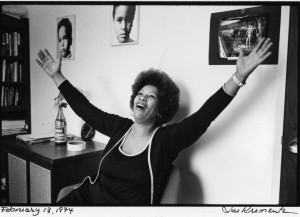 When Toni Morrison began publishing novels in 1970, she did something few American writers have ever done, either before or since, not even William Faulkner: she produced, out of the gate and in succession, three masterpieces, The Bluest Eye (1970), Sula (1973), and Song of Solomon (1977). The third belongs to the heritage of world literature. Her forth, Tar Baby (1981) lacks the mythic power of the first three, but is still a fiercely intelligent work with passages of stunning beauty. Then, in 1987, she published a second Everest, Beloved. After this came Jazz (1992), a perplexing, often gorgeous experiment, less approachable than its predecessors, but with sufficient brilliance to make it recognizably from the same original mind. In 1993 she was awarded the Nobel Prize. All that she had produced up to then made this a ringer for Stockholm.
When Toni Morrison began publishing novels in 1970, she did something few American writers have ever done, either before or since, not even William Faulkner: she produced, out of the gate and in succession, three masterpieces, The Bluest Eye (1970), Sula (1973), and Song of Solomon (1977). The third belongs to the heritage of world literature. Her forth, Tar Baby (1981) lacks the mythic power of the first three, but is still a fiercely intelligent work with passages of stunning beauty. Then, in 1987, she published a second Everest, Beloved. After this came Jazz (1992), a perplexing, often gorgeous experiment, less approachable than its predecessors, but with sufficient brilliance to make it recognizably from the same original mind. In 1993 she was awarded the Nobel Prize. All that she had produced up to then made this a ringer for Stockholm.
Of the five novels she has written since, only one, A Mercy (2008) approaches some of the beauty of those first six. Paradise (1998) is boldly conceived, but strangely tedious. Love (2003), for all it’s good writing, is airless, humorless, lacking scope. Her two latest novels, Home (2012) and God Help the Child (2015) are thin books in every sense. Both scream their hot but circumscribed issues over the weak voices of their characters, more ideograms than personalities. As literary constructions they feel thrown together, as if Morrison filled a file with a certain amount of sketch work then got tired and convinced herself she’d written enough.
What has happened here? How did an unequivocally great writer become a writer of decidedly minor books? Some critics feel the shift happened as early as Beloved, when she began viewing herself as a spokeswoman more than an author, when addressing issues became more important than writing literature. It is often noted that she has become grand where once she had been brave. Still, what happened? I expose myself as hopelessly outré, I know, by positing the daemon theory. I think she has one, and that it helped her produce an early run of stunning, even epochal books. It gave her that opening line, “124 was spiteful. Full of a baby’s venom.” It made her one of the most revered American authors of the century. But it has now revealed itself as one of those nasty sorts who holds to the busybody notion that all good things must exist in balance. And so this latest book weighs in, and all I can say is God help God Help the Child.
